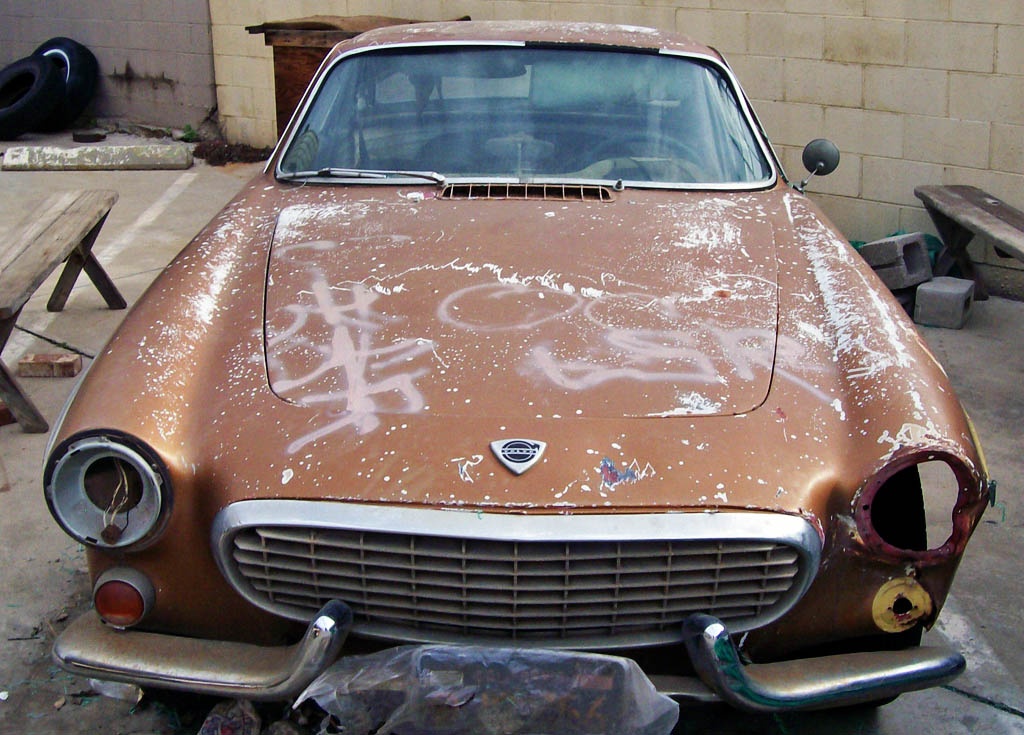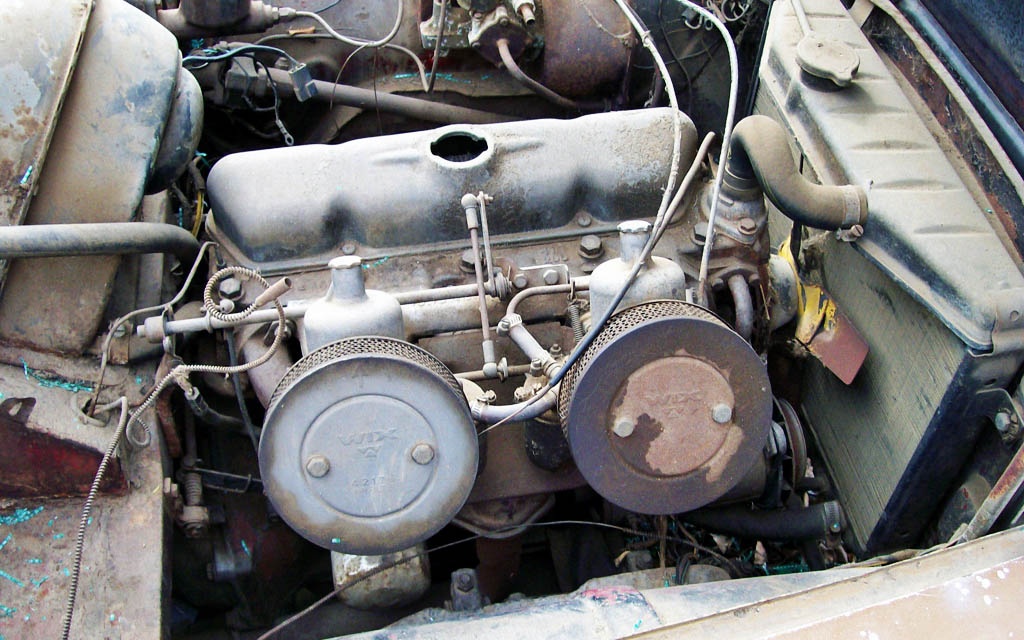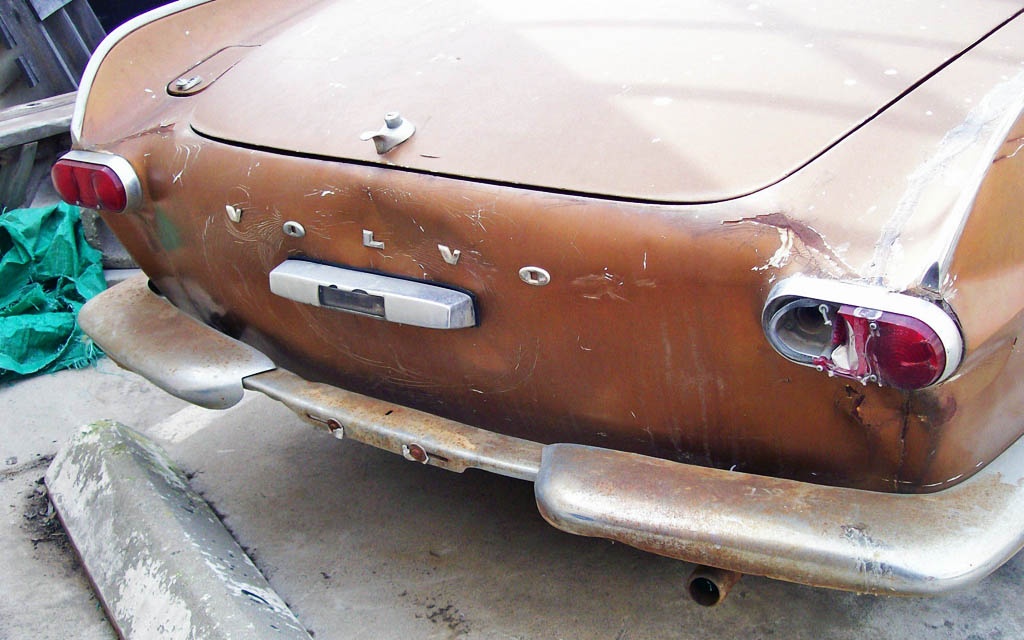I’ve wondered for a long time exactly what logic led Volvo to have the first P1800 bodies built by Jensen in England. Don’t get me wrong; I love British cars. But generally they were and are known for their beauty and charm, not their craftsmanship. As it turns out, it’s a path filled with twists and turns almost as curvy as this Swedish sports car’s body. Jim S alerted us to this great find of a Jensen-bodied P1800 located in Corona, California and available here on eBay.
I was amazed when I read about the convoluted story that ended up with Jensen producing the bodies for the P1800. If you’re interested in the details, they can be found here, here and here. The highlights include a contract designer tricking Volvo into using his son’s design when Volvo thought they were getting an Italian house (Ghia) to design the car, Ghia eventually being forbidden by Volkswagen to produce the tooling or the bodies, and the fledgling European Union making it fiscally attractive for a Swedish company to contract with a British company to produce them. Whew! The end result is what you see here: a stereotype-shattering design that offers a lot of curves with Volvo practicality.
As you can see from the many pictures, this swoopy sports car has seen better days. There are many dents, and a lot of work needed. But the car is stated to have only minor rust, which for an early P1800 is monumental. Poor quality bodies meant Volvo moved production to their own facility after only about 6000 were produced in the UK. Their propensity to disintegrate has led to them to being quite rare.
But does rarity equal desirability? No one denies that later versions are better cars, with sounder bodies, improved creature comforts and mechanicals. But there is something special about owning one of the first of anything. The interior appears complete, even down to a period radio, but needs everything refurbished. The same could be said for the exterior, which while featuring the unusual “cow horn” front bumpers and a full set of original hub caps needs a lot of help. All glass is present and the optional and wonderful Laycock overdrive is there to give the car longer legs. The seller has even done the research to find the original build records of the car and included pictures of the documentation in the auction listing.
Ultimately, the decision is this: if a P1800 appeals to you, would you like the exclusivity of this early car needing a lot of help, or a later, probably less expensive version that you could drive sooner? Let us know below.










SO CAL is great for minimal rust but not so great for cars left neglected and sitting out in the sun for decades.
Jensen made 6,000 of these for Volvo but that was just the first run. After that over 40,000 more were made in 3 more series so there are a lot to choose from. I don’t think the Jensen-made ones are worth a premium so I would keep looking.
.
..Ruff-ruff….
Itsa dog
I think you might be sick. Are you running a fever.? Have you seen a doctor lately.? Are you seeing spots.? This is an ugly brown turd of a car.. hahaha..
It’s a piece of s*** (merdo )
I wonder what the seller meant by “heavy duty” hubcaps. I’m a 122 guy and have never heard this term. Lots of work for the money with very little return. I also wonder about the oil filler cap missing and what moved into the valve train.
U can polish a turd all day , and at the end of the day is all U have is a turd !!!
I like these, a nice looking car. Some of you may or may not have seen the British TV series ‘The Saint’ , played by Roger Moore, driving one of these? That actual TV car was found several years ago in a field, and restored back to how it was in the TV series. It is regularly shown at car shows in the UK these days. I am surprised at your comment though Jamie about British cars not being known for their craftsmanship? SOME of the finest Automobiles in the World are British, think certain models of Jaguar, Daimler, Bentley, Rolls Royce, Aston Martin, older models of Rover and Wolseley to name but a few of many, that have craftsmanship amongst the best in the automotive industry.
Liam, believe me, I’m the ultimate British car lover…we own 9 of them! But as a mechanical engineer by training, I’ve seen many, many rust traps built into British car bodies, and (unfortunately) many examples of less-than-ideal assembly quality. Agreed, I do feel some of the finest autos in the world are British!
Greetings Liam,
Liam, not your usual American name, sounds like something from the British Isles……not being defensive are we?
Seriously, even Jaguar made some serious problematic cars. Everybody did when the manufacturers switched over to unibody construction. Unibody arrived on the scene and nobody was concerned about large boxed sections of metal not being coated with paint, My Mercedes Ponton was no different, Jaguars had problematic cars in the MKII, S-type, 420 and the larger 420G.
Quality problems didn’t start with those models, my MKVII and MKIX both had full frames but it was 20 plus years before I was able to find examples that were worthy of my attention. Far too many Flintstone-mobiles.
Here’s one………Jaguar in their rush to put a model onto the sales floor rushed the preproduction on the 420, the predecessor of the XJ-6 Series One. The body was never tested for harmonics. The engine made sympathetic vibrations in certain frequency ranges that made the amplified and appeared to the driver as a bearing knock, Fearing customers would overload the dealerships with complaints the Engineering Department made a change.
Engineering decided to have the crankshaft shell bearings ground ovoid instead of round the extra material was removed fro the 3 and 9 o’clock positions so loading would not be affected. The end result was to uncouple the vibration which kept the body from amplifying the offending frequencies. They made these bearings well into the 80’s. Heaven forbid you end up using these in a race engine because some parts store still had them on the shelf, they’ll fit most XK engines.
Heater/defrosters…….. all inadequate for the US market, why? Not like the US keeps changing its distance from the equator.
Lucas…….biggest problem here was Lucas still using cloth wrapped harnesses treated with waterproofing wax for the US market long after plastic insulation had been an industry standard, after all there was a reason. One of our summers and the waterproofing wax was missing in action. Having only 2 fuses in my MKII isn’t exactly a great help for a harness either.
British Leyland managed to make poor quality at a much faster rate than had previous ever been expected, ask any Austin, Triumph, MG, Jaguar, Daimler, Rover, etc owners.
Read some of the UK’s periodicals for the details and those were the ones they found during the initial tests, not the long term tests, some of those were hilarious.
For the record, the US companies had their own issues.
It’s not that the British isn’t known for their craftsmanship, they are, it’s just that some of it was bad craftsmanship which is why they had problems in the US market.
Rolls had few issues but considering it’s price a Lincoln was a better value for quality at what 1/10th the price, what’s that saying about the man who knows the cost of everything and the value of nothing.
Love all cars but you seem to have selective memory or a good sense of humor.
This car makes no economic sense whatsoever. First off, it looks like a flood car.
Second, though sourcing parts isn’t too difficult for the 1800, restoring this hulk would run you 30 or 40K. And these cars haven’t hit the P-car bubble yet, so investing that kind of money in one this rough would be folly. Driver examples can be had for 10K or even less.
Finally, this car could rust like nobody’s business, so just because it’s in CA doesn’t mean it isn’t rusted. But I did love the one I re-habbed two years ago…it turned heads like no other car I’ve owned. Unfortunately it didn’t turn the head of the guy who rear-ended me and totaled the car.
Barnfind readers may remember me as being a huge fan of Jensen. I was happy to see that the first “here” link posted is telling the true story. Jensen wasn’t to blame for the bad quality of the bodywork and spent huge amounts of time and money rectifying faults in the panels delivered by Pressed Steel. After Jensen Motors sent many complaints to Volvo, Volvo sent some engineers over, who could do nothing but confirm that Jensen did all they could to supply good bodies but were suffering from the poor quality of the Pressed Steel body panels.
Volvo paid Jensen a healthy sum in compensation and moved production to their factory in Sweden where they now had sufficient production capacity after building new facilities.
Han, thanks for the comment. Pressed Steel made many of the panels for my beloved Triumphs as well…which are for good reason not known for excellent panel fit! P.S. Someday I hope to own an Interceptor :-)
Greetings All,
Han, Pressed Steel also supplied Jaguar. There’s a reason my box has a British Fitment Tool, also known as a hammer, just more expensive to get the proper British version.
Panel fit most times above average but every now and then on newer cars back in the 60’s and 70’s ………clearly they suffered from the Big Three’s Monday and Friday production.
Ross, indeed they did, as well as supplying body panels and even full bodies to Rootes and other UK manufacturers. Perhaps Jensen was too critical?? Fact is that the problems with the panels received from Pressed Steel was not the only issue. Jensen also got less panels than agreed in the Volvo contract so they could not comply to the number of cars agreed in the contract due to circumstances beyond their control. In the end Volvo paid Jensen the handsome sum of 200.000 Pounds Sterling. A lot of money in those years…..
I am the proud owner of a 1963 Volvo 1800S VIN 6374 made in Sweden. A real fun car to drive during our beautiful yet short Nova Scotia ,Canada summers.With the “cow” bumpers(as you called them) the 1800S is known as the “Long Horn” also “The Saint Car”.It drives excellent and is great on the corners with 35mpg +, and yes it’s a major “head turner”! Cheers Bob
Sweet!
Nice car, Bob! Thanks for sharing!
Used to have a 144 which had been fitted with a P1800 B18 motor and gearbox. The P1800 box had electric overdrive, a fifth gear. Unfortunately the extra size of the 144 meant that gear was hardly ever used.
Great to hear these motors running. Loved the clip of the 122s starting up. Havent heard that sound since the 70’s.
Cheers,
John
Brisbane Australia
Greetings,
Forgot to say, still like the car, maybe not the best example but I’m a sucker for Volvo’s with SU’s and Laycock overdrives. That combination should’ve ben standard for MG.
Hi, i’m a owner of a jensen p1800.
I’m restoring him right now.
I think the price for complete restoring this one is about 15K dollars. (See vp autoparts sweden for price parts)
The restored car (only the jensen type) is worth about 55K dollars here in Europe.
Not so bad ide to restore this one.
Hi, I have a question. did the 1963’s have a light in the chrome license plate light holder or were they solid (no hole cut out for the lens. I think the ole in the holder was a back-up light. Any help would be appreciated. I have a ’63 and need a new chrome light holder, one is solid and the other has the back-up light. I want to get the right one as my vin # is 5794 so I know it’s British. thanks in advance.
Have a “63. Vin # 6639, made in Goteberg, Sweden. 1st year back in Sweden. Found it in a back lot of a Korean grocery store. Vines growing thru engine bay and sorts. Paid the guy $350 to take it out of his life. Still needs some work. I would post pics, but do not know how here.